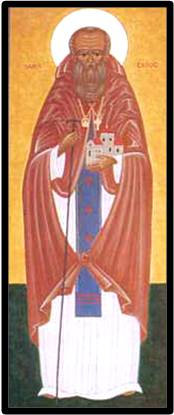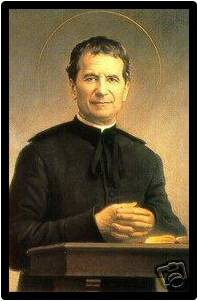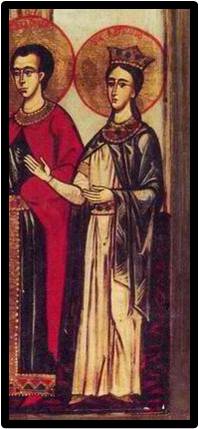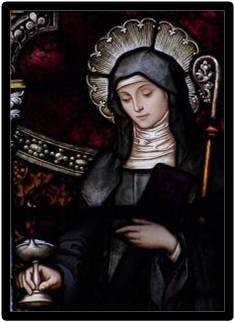
St. Gildas was born at Scotland in Britain and came from a family of English nobility. As a child, he was placed under the care of a nearby monastery where he was trained by Saint Illtyd.
When he grew up, he moved to Ireland to study and give his life over to God by leading a life of sacrifice and penance. Gildas was serious about his Christian commitment and did whatever he could to get closer to God. He felt it was his responsibility to pray and sacrifice for the sins committed by the people of his times.
He wrote sermons trying to convince people to give up wickedness. He encouraged them to stop their lives of shame. Because Gildas cared so much, he was very strict in his writings. Actually, he didn’t mean to find fault with anyone. He was only begging people to turn to God.
After a pilgrimage to Rome Gildas became a hermit, living on the tiny island of Rhuys. He didn’t choose a quiet, prayerful life because he wanted to stay away from the world around him. He chose his life to help him grow closer to God.
He was more aware than most people that some things were very wrong in society. Sadly, many people did not know enough of God and his law. They did not even realize the evils that were destroying them.
Gildas attracted many followers and his hermitage became a monastery. People in the Church - priests, bishops and laymen and women also went to Gildas for advice about deeply spiritual matters. His many writings were aimed at monks, encouraging them to holiness.
Toward the end of his life, Gildas lived his hermit’s life on a tiny island in Houat, Brittany. Even though he wanted to be alone to prepare his soul for death, disciples followed him there. He welcomed them as a sign that the Lord wanted him to share his spiritual gifts with others.
Gildas was like the “conscience” of society. Sometimes we don’t like to hear about sin, but sin is real. Sometimes we, too, are tempted to do wrong or are neglectful. Then we can say a little prayer to St. Gildas. We can ask him to obtain for us the will power to do the right thing.

John Bosco was born in Turin, Italy. His parents were poor farmers. His father died when John was only two years old. John and his brothers helped their mother work on the farm as she struggled to keep the family together. As soon as he was old enough, John, too, worked as hard as he could to help his mother.
He was intelligent and full of life. By the age of nine, John wanted to become a priest and his mother let him go to school. John used to wake up early in the morning to do his chores before he left for school. Finally, a holy priest, St. Joseph Cafasso, found out about John’s wish to be a priest. Father Cafasso helped him enter the seminary.
He learned to do all kinds of trades. He was a carpenter, a shoemaker, a cook, a pastry maker and a farmer. He did many other jobs as well. He didn’t realize how much this knowledge would help others later.
John would go to circuses, fairs and carnivals, practice the tricks he saw magicians perform, and then present one-boy shows. After his performance, while he still had an audience of boys, he would repeat the sermon he had heard in church that day. John became a priest in 1841.
As a priest, Don Bosco, which means Father Bosco, began his great ministry. This kind priest felt sad when he saw so many children living on the streets of Italy. Like a loving father, he gathered together these homeless boys and taught them trades. This way they would not have to steal or get into trouble.
Many rich people gave him money to help build workshops. He later started a printing press so he could print books and leaflets to teach people about God’s love for them and how to be good Christians.
By 1850, there were 150 boys living at his home for boys. Don Bosco’s mother was the housekeeper. He loved these children, however naughty they were, and the boys loved him because John Bosco always encouraged them.
“Do you want to be Don Bosco’s friend?” he would ask each new boy who came to him. “You do?” he would ask happily. “Then, you must help me save your soul,” he would say.
Every night he asked his boys to say three Hail Mary’s, so that the Blessed Mother would help them keep away from sin. He also helped them receive the sacraments of Reconciliation and Holy Communion often and with love.
Every morning he would say Mass for his students giving them beautiful sermons and telling them interesting stories. He asked the young boys to imitate Jesus in everything they did - whether it was work, study or play and told them that God wanted everyone to be saints as He had a great reward waiting for them.
His advice to them was, “Pray when it’s time to pray. Study when it’s time to study. Play when it’s time to play. Show kindness to everyone you meet. But do it all for the love of Jesus.”
One of the boys listening very carefully was young Dominic Savio who told John Bosco that he would try very had to become a saint and please God. And he did.
Don Bosco started his own religious order of priests and brothers. They were called the Salesians, after St. Francis de Sales. Then he started the order of Salesian sisters with the help of St. Mary Mazzarello. These men and women pray and teach young people about God’s love in countries all over the world even today.
Don Bosco died on January 31, 1888. All the people of Turin came out on the streets to honor him. His funeral became a joyous proclamation of thanksgiving to God for the life of this wonderful man.




